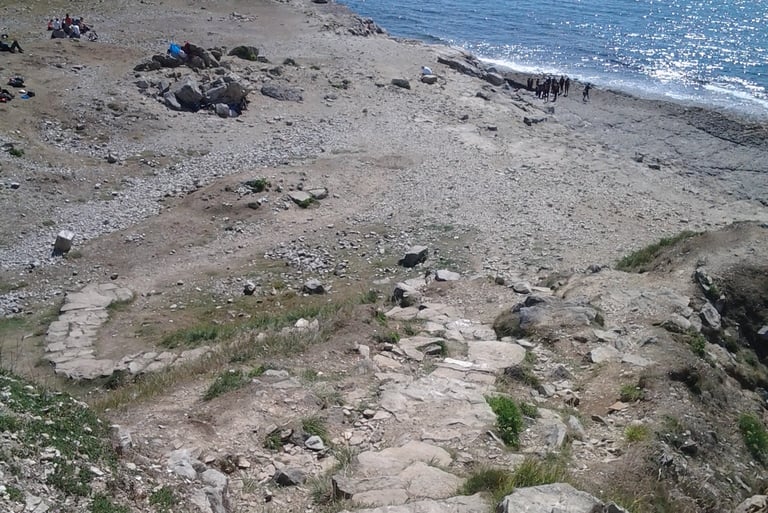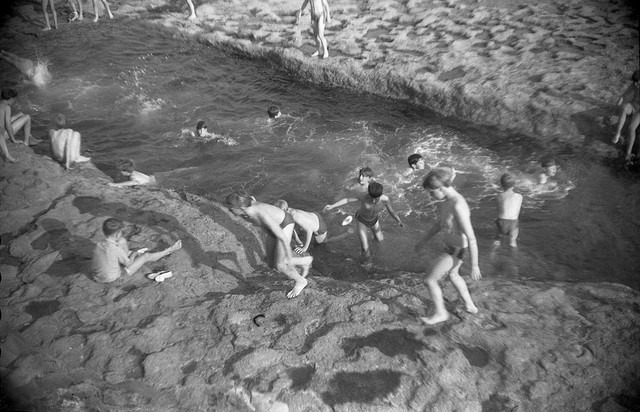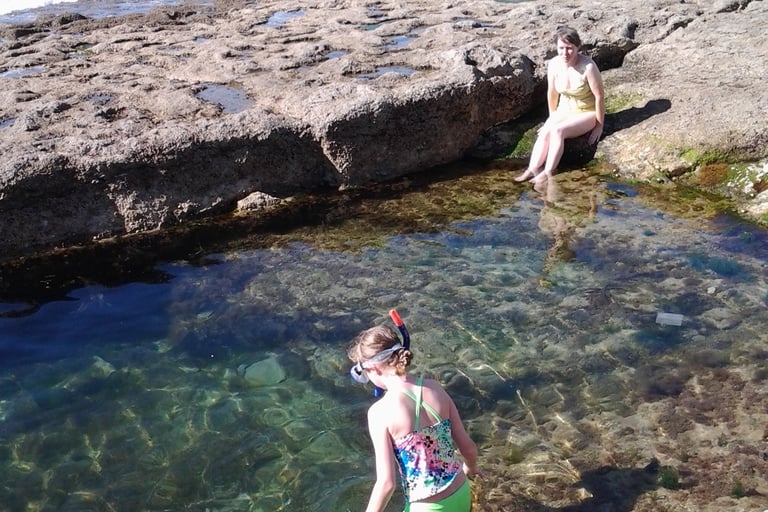Dancing Ledge: From Smugglers' Haven to Wild Swimming Destination
DANCING LEDGESWIMMING, DORSETJURASSIC COASTDORSET COASTLINE
8/6/20256 min read


Source: Unsplash
Dancing Ledge is a point on the South West Coast Path, close to the villages of Worth Matravers and Langton Matravers. It features in a pivotal chapter in my novel, A Dorset Lammas.
The origin of the name is not definitive. The two most common explanations are that it derives from the way the waves appear to dance as they lap over the rock, or that the ledge is about the area of a ballroom (though it’s hard to imagine dancing across the uneven rock without twisting an ankle). A less favoured suggestion is that the name is a corruption of ‘Dark Spring Ledge’, referring to the dark, slimy trails left by springs trickling down the cliff.
Dancing Ledge is a natural shelf in the cliff face, although the surrounding cliffs are shaped by quarrying for the famous Portland Stone that graces many a London edifice. The sheer drop from the edge of the rock shelf into the sea makes it possible for small boats to come right up to the ledge. This was important because Portland stone was initially transported via sailing barge. Although the days of Dorset’s ubiquitous family quarries are gone, you can still see the evidence of the quarrying in the man-made caves interspersed with the sea caves formed from natural erosion.
The continuous shipping activity of the individual quarries, and the numerous small caves in the cliffs, benefitted Dorset’s other popular trade, smuggling, as the coming and going made it easier for men to slip in contraband unnoticed – especially since quarrymen and smugglers could be one and the same. According to the website ‘Smugglers’ Britain’, after landing at Dancing Ledge, ‘Goods were taken up over the hill to Spyways Farm for temporary storage (on occasions guarded by a bull) and from there to the church at Langton Matravers, where tubs were stored in a void above the ceiling in the church roof.’ There is an anecdote that one Sunday, the choir were singing Psalm 65, and as they got to the words ‘Thou crownest the year with thy goodness; and thy paths drop fatness,’ the roof collapsed, dropping kegs on the congregation’s heads.


The descent to Dancing Ledge. Source: Own photo.
Although the ledge is a natural phenomenon, Dancing Ledge’s most notable modern feature, its swimming pool, is not. The pool was blasted out of the rock around 1910 to make a swimming pool for the local boys prep school, Durnford. At first, it was kept covered with a locked iron grille when not in use, but this was soon swept away in a storm and never replaced. Apparently ‘strip and swim’ was a mandatory morning ritual for the boys, overseen by the headmaster, Thomas Pellatt, first bathing off the ledge itself and later in the pool. Durnford school is now closed, but one famous pupil who suffered the bad food, bullying and cold swims was Ian Fleming, author of the James Bond spy novels. ‘I’m afraid I do not like school very much,’ he lamented to his mother. ‘I have not made many friends, they are so dirty and unreverent.’ Perhaps, then, the headmaster had a point with his sea baptisms-cum-baths.
Another nearby progressive prep school, Spyways, also used the pool, and also apparently had naked swimming (I read that the joint brother headmasters were naturists). Browsing through the Spyways school blog, it’s of note that the majority of memories posted include the mandatory swimming lessons at Dancing Ledge, with regular comments such as ‘terrifying’ and ‘dreaded’; ‘If you graduated to the actual Atlantic Ocean, and did not drown at once, you were sure to be hideously cut as you tried to time the wave that put you back onto the Ledge.’ Only a few seem to look back on the swimming lessons with fondness; one old boy recalls ‘Running down the hill to Dancing Ledge with a towel as an air brake’ (all quotes from the blog entry of Oct. 2008).


Apparently, swimming wasn't always in the nude. Source: spywayschool.blogspot.com
I made a voluntary visit to Dancing Ledge, and wore a swim suit, but it was about eleven years ago, so some of my memories may be a little hazy. We took the easiest route, parking in the Spyway Barn car park and taking the walk over the steep, curving hills down to the cliff (the botanically minded can try to orchid spot on the way down). The final part of the trek, whichever route you take, is in two stages: first you take stone steps down to the upper level of the quarry area, and then you need to summon your rock-climbing skills for a short scramble down the cliff face to the ledge – it took us a combined family effort to guide each other down safely. I recall reading somewhere that there used to be a ladder, but this has never been restored, perhaps to keep visitor numbers down. Whatever the case, obviously, a visit is not suitable for those with mobility issues or for dogs.
Once down on the ledge, if you are at all interested in geology, you can look back up and admire the rock formations, which struck me as resembling a many-layered cake (although a geologist would throw around terms such as ‘prickle bed’, ‘cherty bed’, ‘thrombolite’, or ‘Portland freestone’), or hunt for ammonites embedded in the rocks beneath your feet. I’m not a geologist, but a lifetime of visiting the Jurassic Coast and of fossil hunting and rockpooling has given me a layman’s appreciation of Dorset’s rock formations. (Incidentally, I’ve heard there is a colony of puffins nearby, though sadly I did not see them.)
The pool has become a popular wild swimming destination, although it is recommended not to go over the edge and swim in the sea due to the lack of a shoreline for easy entry and exit and to the potentially dangerous currents (there was a death there as recently as 2019). Apparently, this did not bother the headmasters of Durnford and Spyway Schools. I'm not sure if it was kept clean when a school pool, but now it resembles a giant rock pool, full of weeds and sea life, which was part of its appeal for me. My children and I “enjoyed” a very cold swim. As you can see from the photograph, we had a tranquil visit, admiring the pool and the view across the sea... until the place was invaded by a school holiday group. I can’t quite remember whether they arrived by boat, or climbed down the cliff and were picked up by boat, but the end result was the same. I gather that Dancing Ledge is a popular place for climbing and coasteering, so be warned when you pick a time to visit. The cliffs surrounding it are also apparently a popular choice for tombstoning (jumping vertically from a height into water). Funny that all the things those long-ago schoolboys dreaded are now sought-after experiences. I wonder what they would make of us.


Source: Own photo.
As a point on the South West Coastal Path, you can take in a visit to Dancing Ledge as part of many hiking routes. As I mentioned above, the Spyway Barn car park is an easy option; an example of a walk from Spyway Barn can be found at the South West Coast Path website. If the school aspect has caught your attention, you can get lost in the Spyways blog. If you’re a rock geek, there is a slightly clunky but fascinating and comprehensive discussion of Dancing Ledge from the geology (and recreational) perspective at the Wessex Coast Geology website. Or if you’re on the reckless side, get an overview of Dorset smuggling at smuggling.co.uk.
Other sources consulted:
https://en.wikipedia.org/wiki/Durnford_School
https://www.ianfleming.com/timeline/enrolment-at-durnford/?v=7885444af42e
